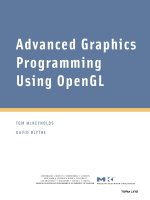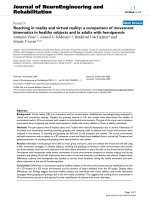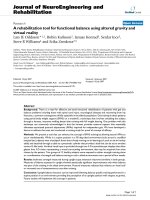Lecture computer graphics and virtual reality slides lesson 5 modeling transformation
Bạn đang xem bản rút gọn của tài liệu. Xem và tải ngay bản đầy đủ của tài liệu tại đây (1.15 MB, 48 trang )
Lesson 5
Modeling
Transformation
Trinh Thanh Trung School of ICT, HUST
Content
1. Transformation
2. 2D modeling transformation
3. Homogenous transformation
4. 3D modeling transformation
1.
Transformation
Transformation Definition
■ What is a transformation?
□ P′=T(P)
□ Transform the coordinates / normal vectors of
objects
■ Uses
□ Moving the objects to the desired location in the
environment
□ Multiple instances of a prototype shape
□ Kinematics of linkages/skeletons – character
animation
□ Viewing
□ Virtual camera: parallel and perspective projections
Types of transformation
■ Object Transformation alters the coordinates of
each point according to some rule, leaving the
underlying coordinate system unchanged
■ Coordinate Transformation produces a
different coordinate system, and then represents all
original points in this new system
Stages of transformation
Model MODELING World VIEW Display
Coordinate TRANSFORMS Coordinate TRANSFORMS Coordinate
System System System
PROJECTION Projection
Coordinate
TRANSFORMS
System
Modeling
Transformation
View
Transformation
Projection
Transformation
Affine transformation
■ Whole collections of points may be transformed
by the same transformation T, e.g. lines or circles
■ The image of a line, L, under T, is the set of all
images of the individual points of L.
■ For most mappings of interest, this image is still
a connected curve of some shape
■ For some mappings, the result of transforming a
line may no longer be a line
■ Affine Transformations, however, do preserve
lines, and are the most commonly-used
transformations in computer graphics
Affine transformation properties
■ Preservation of lines:
□ They preserve lines, so the image of a straight line is
another straight line.
□ This vastly simplifies drawing transformed line
segments.
□ We need only compute the image of the two
endpoints of the original line and then draw a
straight line between them
Affine transformation properties
■ Preservation of co-linearity
□ Guarantees that polygons will transform into
polygons
■ Preservation of parallelism
□ Guarantees that parallelograms will transform into
parallelograms
■ Preservation of proportional distances
□ Mid-points of lines remain mid-points
Affine transformation
■ Any Affine transformation can be decomposed
into elementary transformations
1. Translation
2. Scaling
3. Rotation
4. Shearing
2.
2D transformations
Matrix representation
■ All affine transformations in 2D can be
generically described in terms of a generic equation
as follows:
Qx a b Px tx
= +
Qy c
d Py t y
■ or
Q = MP + t
Translation
■ A translation moves an object into a different
position in a scene
xnew = xold + tx ynew = yold + ty
y 1 2 3 4 5 6 7 8 9 10 x
6 Note: House shifts position relative to origin
5
4
3
2
1
0
Translation
■ Translation is achieved by adding an offset/
translation vector tx
t=
ty
■ In Vector notations
Q x P = x t + x
Qy Py t y
P’ = P + T / x/ tx Transformation
x P = / T = matrix
P= y ty
y
Scaling
■ Scaling multiplies all coordinates
□ Alters the size of an object
xnew = Sx × xold ynew = Sy × yold
y
6
5
4
3 6 9
3 3
2
1 2 3
1 1
0
1 2 3 4 5 6 7 8 9 10 x
Note: House shifts position relative to origin
Scaling
■ A scaling changes the size of an object with two
scale factors, Sx and Sy
□ if Sx != Sy, then we have a non-uniform scale
Qx Px Sx
=
Qy Py S y
P’ = S.P x / x/
P = P = /
y y
sx 0
□ Transformation matrix S=
0 sy
Rotation
■ To generate a rotation, a rotation angle θ and
the position (xr, yr ) of the rotation point is needed
x = r cos , y = r sin
y x’ = r cos ( + ), y’ = r sin ( + )
6 x’ = r ( cos cos - sin sin )
5
4 = x cos - y sin
3 y’ = r ( sin cos + cos sin )
2 = x sin + y cos
1
x
0
1 2 3 4 5 6 7 8 9 10

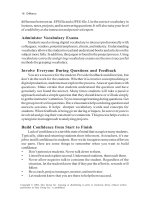
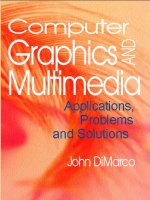


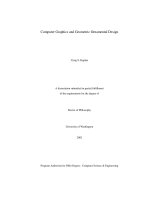
![mathematical foundations of scientific visualization, computer graphics, and massive data exploration [electronic resource]](https://media.store123doc.com/images/document/14/y/up/medium_upb1401358803.jpg)
